Remembering the Super CubBy Bob RitterThe year 2008 represents a significant milestone in the history of motorcycling. It was sixty years ago that the Honda Motor Company was founded. (True…Honda started making motorcycles a few years earlier, but 1948 was the official date of the company’s inception.) 2008 also marks the 50th anniversary of the initial introduction of the Honda Super Cub – the most significant motorcycle in my opinion. Why do I hold the Super Cub as such an important machine? In 1958 when the Super Cub model was introduced, it was very different from any other motorcycle. It had many unique and new design features that set it apart from any other vehicle, then or even now. | |
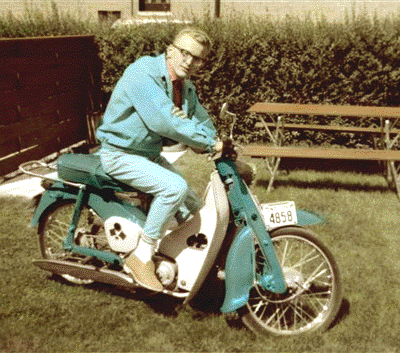
|
The first unique feature was in the engine. (After all, it was the Honda MOTOR Company!) It had a 50cc power plant that was four-cycle instead of the typical two-cycle design for that small a size. In spite of the fact that his company had previously manufactured two-cycle engines, Mr. Honda had insisted that the new design be a four-stroke. This was because he had grown to despise the sound and the smoke generated by the two-cycle design. Besides, a four-stroke was more efficient in the amount of fuel it consumed. However, the power that could be produced from small engines was limited and most engineers believed that one so small could not produce enough power unless it was two-stroke. The Honda design was new and efficient, and it produced comparative ample power thanks to its overhead valves and slightly domed piston. The valves were made as large as possible, but with such a small cylinder to work with this limited the room left for a sparkplug. The smallest plug at the time was 12mm in diameter, so Honda convinced NGK to make plugs that were only 10mm in size. Thanks to careful construction and close tolerances, the little engine whizzed to 9,500 RPM where it produced almost 5 HP. |
| The second unique feature of the machine was in the transmission and particularly the operation of the clutch. The clutch was automatic in that the operator selected the three gears without any clutch lever to manipulate. Thanks to an ingenious design the clutch mechanism disengaged positively with the shifting and smoothly re-engaged upon acceleration due to centrifugal operation of its cams. Only one hand was needed to operate and shift the vehicle, leaving the other hand free to carry a package of noodles for delivery! | |
| Most noticeable as being unique was the design of the body. Somewhat similar to the scooters that Mr. Honda had observed which were becoming popular in European cities, the Super Cub was a “step-through” construction such that the operator stepped onto the motorcycle rather than needing to throw a leg over it. The gas tank wasn't straddled either, as it resided under the seat. As well, the operator's legs were protected by a legshield, constructed from a new plastic called polyethylene. This plastic material was also used to form various other parts of the machine: e.g. the side panels, the front fender, and the headlight case. Injection molding could form all these plastic parts and they were colour impregnated so that painting wasn't necessary and scratches and scuffs wouldn't show too badly. Besides that later asset, the plastic parts were flexible and could withstand abuse that metal would crumble under. The plastic parts were lighter than comparable metal pieces and overall they were cheaper to manufacture in volume. The rest of the body, or the frame as it would be described, was a series of stamped steel pieces that were welded together to form a solid structure. This frame structure also included the rear fender and provided a rigid platform to mount the rear shocks, swing arm, seat, and motor. A solid tubular piece extended up to the steering head and was hidden under the leg shield. The little Honda also had all the latest electrical amenities – including somewhat adequate lighting and turn signals powered by a 6-volt battery system. An electric starter was even available on one model that was introduced a few years after 1958. |
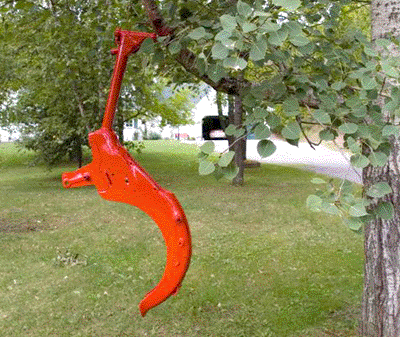
|
| A final new feature of the design was in the wheels. These were not small diameter like most scooters, but instead were large diameters making them easier to navigate rough roads. The diameter chosen for proper proportions of the small machine was 17”. But that size of motorcycle tire had never been made before, so Honda convinced Bridgestone to start making tires just for this model of motorcycle. All these features were very fresh in 1958 – but they are still quite distinctive today. In fact the 50cc Super Cub, not much different from the 1958 model, is still manufactured for certain Asian markets. Since that original introduction, over 50 million copies of Honda Super Cubs have been made. That makes it by far the most produced model of vehicle ever constructed in the history of motoring! It wasn't in 1958 that I began my motorcycling experience, but a few years later when I was in high school in Woodstock, Ontario. In the spring of 1964 I acquired from a friend a blue Super Cub that was a year old. This was the motorcycle that I learned to ride on, and many other young people at the time also learned “to ride” on the Super Cub. My machine was actually a 55cc version of the same original. This displacement was never offered in the USA as a Super Cub (although they had a somewhat similar Trail model) but it was very popular in Canada as it produced a claimed true 5.0 HP as opposed to the 4.5 of the 50cc model. Also different on the Canadian models was the retention of turn signals, which had been dropped in the USA at the insistence of DOT. A 55cc model was claimed to do 46mph (75kph) while the 50cc only did 43mph (70kph). With ideal conditions and contorted body position, mine was able to register 55mph before the valves started floating! I'm sure that it was due to my youthful attitude that my claim to shame is that the only speeding ticket I have ever received on a motorcycle was on that Super Cub. | |
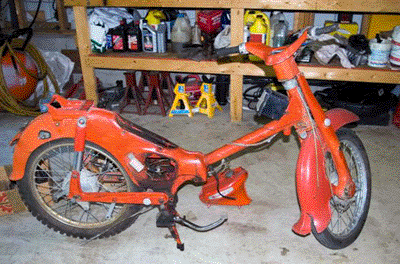
|
I mentioned earlier that the four-cycle design was fuel-efficient. The Super Cub had a claimed fuel consumption of 254 miles / Imp. gallon. With only a 3-liter tank (including a reserve) this optimistic estimate still gave reasonable traveling range in reality. I could ride around all week all over the place on only one tank of gasoline. Then I'd go to the station to have the attendant fill me up again. (There weren't self-serve stations back in the mid-60's so only an attendant could pump gas.) After he'd topped me up I'd give the attendant a quarter – and he'd give me change! Try buying less than $0.25 of gasoline today! |
| My little Cub and I had lots of adventures together: Once a pair of Dobermans chased me after I had wandered into some nice trails on private land. Another time I got waves from a whole troupe of black-leather jacketed Harley riders with their women hanging off the back. That frightened me more than the dogs, as I kept looking over my shoulder for miles after that, imagining that they might have turned-around and started to chase me. In retrospect, they were probably some retired guys out for a nice ride with their wives, looking for a coffee shop. (I know that now.) Another adventure was group riding with my own buddies – all of us on small machines of less than 100cc. We’d all go buzzing down the highways in single line formation. We'd have our machines cranked as fast as they would go, with the fastest leading and the rest getting dragged along in the others' slipstream – and we would hardly be breaking any speed limits! Slipstreaming was a fine art that we perfected, and we also knew all about the slingshot pass that was possible to do with a slower machine. I think today they've re-learned that technique on the racetrack at Daytona. | |
| Today, in my retirement, I teach motorcycle riding to new riders and I have a collection of small Hondas from the 1960’s. As well, I ride a newer Gold Wing. The Wing has a total displacement of 1800cc, and each of its six pistons displace almost six times the capacity of my little Super Cub. But I don’t get the chance to do any more of those slingshot passes…and that’s probably just as well. However, I do have a lovely little 1964 Super Cub in my collection. It’s red (all my Hondas are now red) and I recently finished a complete restoration of it. Although it's not entirely authentic as an original 1964 would be, I still think it looks pretty. Besides, it looks a lot better than the sorry condition it was in when I started the restoration. Now, I wonder if I can get it out of the poolroom and if it will start... and maybe someone will want to learn the art of slipstreaming. |
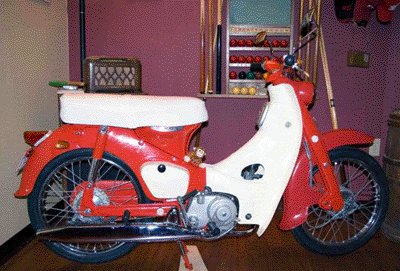
|
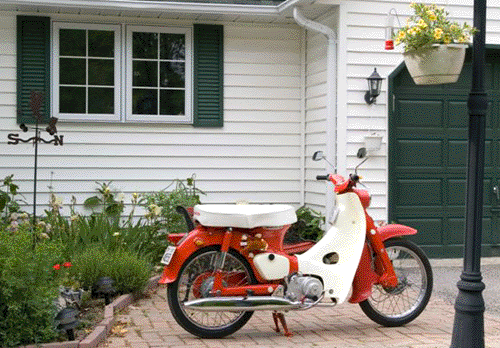
Bob's Super Cub as of June 2008. Once out of the poolroom it started easily, ran well and completed a four mile journey before this photo was taken. You can see there is no trace of leakage underneath it.
| |
|
Bob Ritter is a riding instructor with the Rider Training Institute www.ridertraining.ca And a member of the Canadian Vintage Motorcycle Group (CVMG) www.cvmg.ca/ | |

